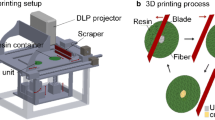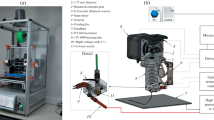Abstract
Fiber-reinforced composites have provided tremendous opportunities in advanced engineering materials, but the fiber generation and spatial distribution are the most challenging aspects. This paper proposes a novel fabrication approach for fiber-reinforced composites with spatially resolved fiber distribution by combining immersion and near-field electrospinning. The new Immersed Electrohydrodynamic Direct-writing (I-EHD) process makes use of an electrostatic force to draw ultrafine fibers and allows the freestanding of electrospun fibers all inside a liquid matrix. This novel approach enables the dynamic control of fiber morphology and 3D spatial distribution inside the composites, which may lead to future scalable 3D printing of multifunctional composites.
Graphical abstract





Similar content being viewed by others
Data availability
The authors declare that the data supporting the findings of this study are available within the paper. Additional raw data are available from the corresponding author on reasonable request.
References
Y. Xu, P. Guo, A.-T. Akono, Novel wet electrospinning inside a reactive pre-ceramic gel to yield advanced nanofiber-reinforced geopolymer composites. Polymers 14(19), 3943 (2022)
M.T. Aljarrah, N.R. Abdelal, Improvement of the mode i interlaminar fracture toughness of carbon fiber composite reinforced with electrospun nylon nanofiber. Compos. Part B: Eng. 165, 379–385 (2019)
J. Xue, T. Wu, Y. Dai, Y. Xia, Electrospinning and electrospun nanofibers: methods, materials, and applications. Chem. Rev. 119(8), 5298–5415 (2019)
A.L. Yarin, S. Koombhongse, D.H. Reneker, Bending instability in electrospinning of nanofibers. J. App. Phys. 89(5), 3018–3026 (2001)
L.M. Shepherd, M.W. Frey, Y.L. Joo, Immersion electrospinning as a new method to direct fiber deposition. Macromol. Mater. Eng. 302(10), 1700148 (2017)
X. Wang, K. Nakane, Preparation of polymeric nanofibers via immersion electrospinning. Eur. Polym. J. 134, 109837 (2020)
S. Li, B.-K. Lee, Morphological development of immersion-electrospun polymer products based on nonsolvent-induced phase separation. ACS Appl. Polym. Mater. 4(2), 879–888 (2022)
M. Saadi et al., Direct ink writing: a 3d printing technology for diverse materials. Adv. Mater. 34(28), 2108855 (2022)
J.T. Muth et al., Embedded 3d printing of strain sensors within highly stretchable elastomers. Adv. Mater. 26(36), 6307–6312 (2014)
A.K. Grosskopf et al., Viscoplastic matrix materials for embedded 3d printing. ACS Appl. Mater. Interfaces 10(27), 23353–23361 (2018)
R.D. Weeks, R.L. Truby, S.G. Uzel, J.A. Lewis, Embedded 3d printing of multimaterial polymer lattices via graph-based print path planning. Adv. Mater. 35(5), 2206958 (2023)
B. Román-Manso, R.D. Weeks, R.L. Truby, J.A. Lewis, Embedded 3d printing of architected ceramics via microwave-activated polymerization. Adv. Mater. 35(15), 2209270 (2023)
M. Wehner et al., An integrated design and fabrication strategy for entirely soft, autonomous robots. Nature 536(7617), 451–455 (2016)
Z. Zhang, H. He, W. Fu, D. Ji, S. Ramakrishna, Electro-hydrodynamic direct-writing technology toward patterned ultra-thin fibers: advances, materials and applications. Nano Today 35, 100942 (2020)
J. Zhong et al., Effect of surface treatment on performance and internal stacking mode of electrohydrodynamic printed graphene and its microsupercapacitor. ACS Appl. Mater. Interfaces 15(2), 3621–3632 (2023)
W. Zou et al., Electrohydrodynamic direct-writing fabrication of microstructure-enhanced microelectrode arrays for customized and curved physiological electronics. Adv. Mater. Interfaces 9(31), 2201197 (2022)
S. Wang, X. Mei, S. Wang, B. Xu, Micro/nanofluidic transport by special fibers deposited by electrohydrodynamic direct-writing. Mater. Des. 225, 111518 (2023)
X.-X. He et al., Near-field electrospinning: progress and applications. J. Phys. Chem. C 121(16), 8663–8678 (2017)
F.-L. He et al., A novel layer-structured scaffold with large pore sizes suitable for 3d cell culture prepared by near-field electrospinning. Mater. Sci. Eng.: C 86, 18–27 (2018)
Y.-S. Park et al., Near-field electrospinning for three-dimensional stacked nanoarchitectures with high aspect ratios. Nano Lett. 20(1), 441–448 (2019)
W.K. Son, J.H. Youk, T.S. Lee, W.H. Park, The effects of solution properties and polyelectrolyte on electrospinning of ultrafine poly (ethylene oxide) fibers. Polymer 45(9), 2959–2966 (2004)
Y. Xu, J. Ndayikengurukiye, A.-T. Akono, P. Guo, Fabrication of fiber-reinforced polymer ceramic composites by wet electrospinning. Manuf. Lett. 31, 91–95 (2022)
W. Oliver, Pharr gm. J. Mater. Res. 1992, 7 (1992)
W.C. Oliver, G.M. Pharr, An improved technique for determining hardness and elastic modulus using load and displacement sensing indentation experiments. J. Mater. Res. 7(6), 1564–1583 (1992)
A.L. Yarin, S. Koombhongse, D.H. Reneker, Taylor cone and jetting from liquid droplets in electrospinning of nanofibers. J. Appl. Phys. 90(9), 4836–4846 (2001)
D.H. Reneker, A.L. Yarin, Electrospinning jets and polymer nanofibers. Polymer 49(10), 2387–2425 (2008)
A. Doblies, B. Boll, B. Fiedler, Prediction of thermal exposure and mechanical behavior of epoxy resin using artificial neural networks and Fourier transform infrared spectroscopy. Polymers 11(2), 363 (2019)
Acknowledgments
This research was partially supported by the National Science Foundation under grant number CNS-2229170 and grant number DMR-1928702. This work was also supported by the National Science Foundation under Grant No. 1747452, which supported Nathanial Buettner in his Ph.D. studies. This work made use of the EPIC facility of Northwestern University’s NUANCE Center, which has received support from the Soft and Hybrid Nanotechnology Experimental (SHyNE) Resource (NSF ECCS-1542205); the MRSEC program (NSF DMR-1720139) at the Materials Research Center; the International Institute for Nanotechnology (IIN); the Keck Foundation; and the State of Illinois, through the IIN.
Author information
Authors and Affiliations
Corresponding author
Ethics declarations
Conflict of interest
The authors declare no conflict of interest.
Additional information
Publisher's Note
Springer Nature remains neutral with regard to jurisdictional claims in published maps and institutional affiliations.
Rights and permissions
Springer Nature or its licensor (e.g. a society or other partner) holds exclusive rights to this article under a publishing agreement with the author(s) or other rightsholder(s); author self-archiving of the accepted manuscript version of this article is solely governed by the terms of such publishing agreement and applicable law.
About this article
Cite this article
Xu, Y., Buettner, N., Akono, AT. et al. Fabrication of fiber-reinforced composites via immersed electrohydrodynamic direct writing in polymer gels. MRS Communications 13, 1038–1045 (2023). https://doi.org/10.1557/s43579-023-00399-2
Received:
Accepted:
Published:
Issue Date:
DOI: https://doi.org/10.1557/s43579-023-00399-2




